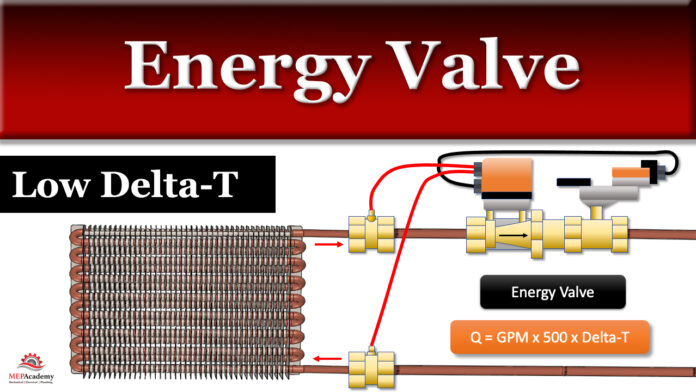Energy Valve. In this article we’ll learn how an Energy valve works, how it saves energy, where it is used and how it can prevent the low Delta-T syndrome.
If you prefer to watch the YouTube Video of this presentation, then scroll to the bottom or click on this link. Energy Valve Video
Here is the Energy valve. It has an ultrasonic Flow meter that measure the flow (GPM) going through the piping. This gives us the GPM in our equation. Then we have temperature sensors on the supply and return piping to our heat exchanger or coil. This will give us the Delta-T in our equation.
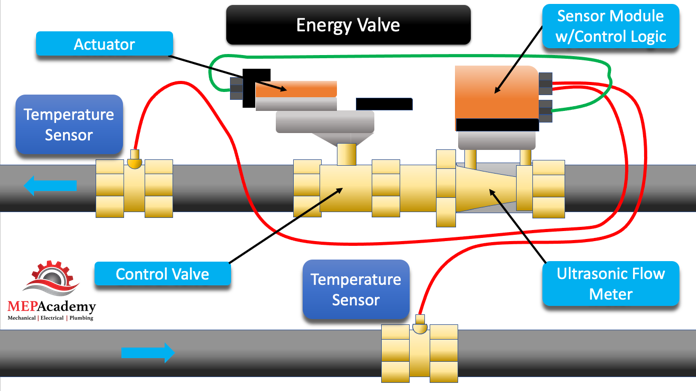
With these two values the Energy Valves onboard controls logic can determine the energy, or the Q in our equation which is the BTU/Hour. This consumption of energy can be used to bill a tenant for their use of the chilled water or heating hot water system.
To adjust the flow or GPM, the Energy Valve will modulate the Actuator on the Control Valve. The GPM is adjusted to reach the Delta-T setpoint of the Energy Value.
We can install these Energy Valves on the Coils feeding an Air Handling unit, and install Temperature sensors and the connecting cabling.
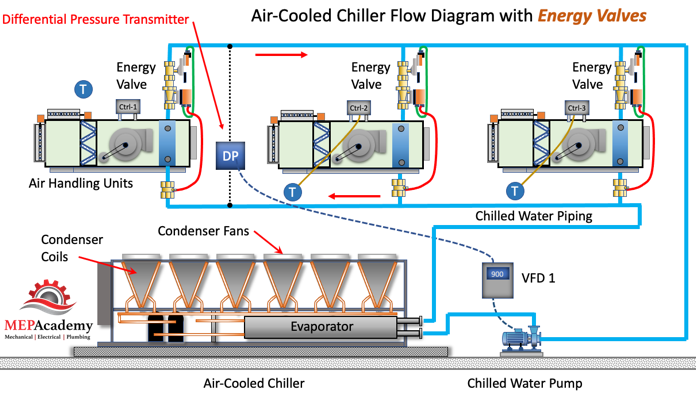
We can look at the difference between maintaining Delta-T with an Energy Valve and the traditional system. We converted our formula to solve for GPM. Using a heat load of 120,000 Btu/Hr. or 10-Tons, we get 15 GPM if the Energy Valve is maintaining the Delta-T at a setpoint of 16 degrees. The traditional system has slipped to a 6 degree Delta-T, requiring 40 GPM to get the required heat transfer. This additional GPM causes an increase in pump energy, and would require larger piping. The size of the piping for the Energy valve system would be 1-1/4”, while the traditional system would require 2” to match the same heat transfer quantity.
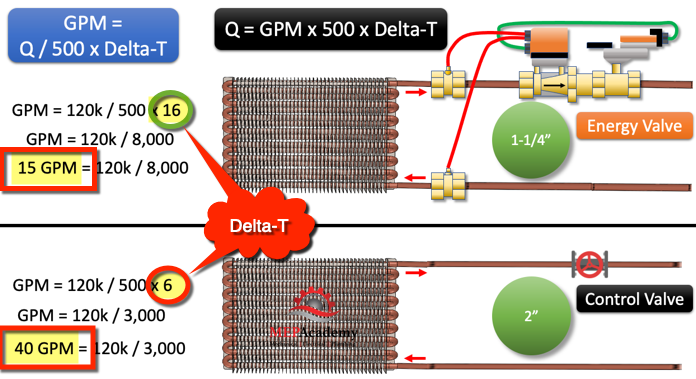
If the heat load drops to 36,000 Btu/Hr., which is 30% of the peak design load, then we get 4.5 GPM through the Energy Valve at a 16 degree Delta-T. The traditional system is requiring 12 GPM to get the required heat transfer. Saving energy requires managing the Delta-T through the heat exchanger so that the pumps and central plant equipment runs efficiently.
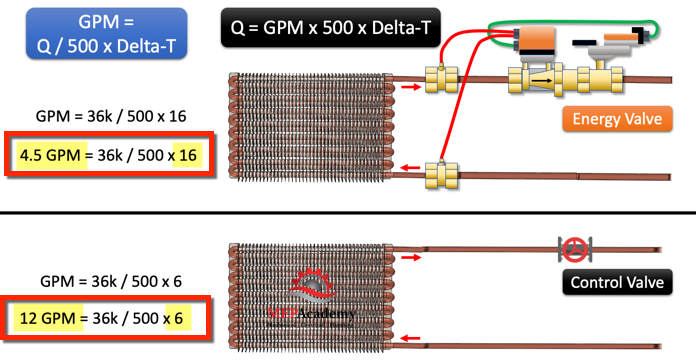
Air Handler Coils and Energy Valves
The Energy valve can be used with Air Handlers as shown here. The contractor installs the Energy Valve and a Temperature Sensor on the Chilled Water Supply piping. Connection can be made to a Building Management System for remote monitoring, data collection and programming.

Fan Coils and Energy Valves
The Energy Valve can be installed on Fan Coil Units also.
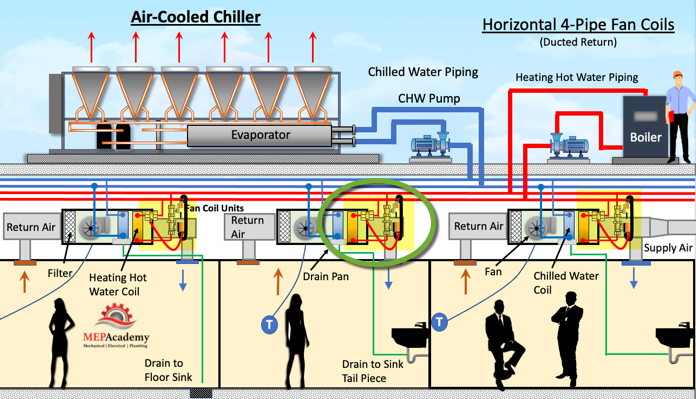
Chilled Beams and Energy Valves
The Energy Valve can be installed on Chilled Beams. The Valve can be installed on just about any coil or heat exchanger to manage Delta-T and avoid the Low Delta-T Syndrome.
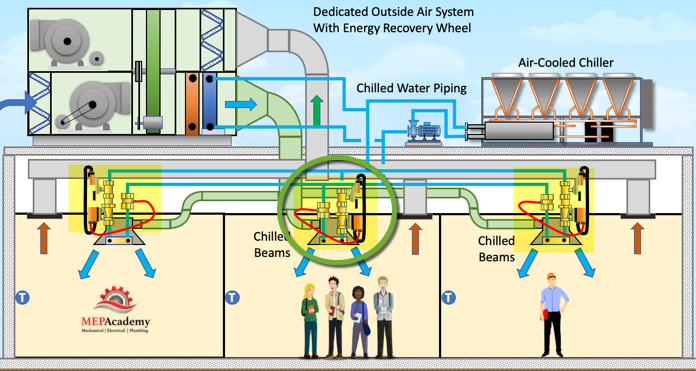
Low Delta-T Syndrome
Tracking the Delta-T of the water being delivered to HVAC Coils is important in maintaining an efficient system. The valve tracks the current Delta-T and compares it to the set-point Delta-T to be maintained, making adjustments as required to keep it at minimum set-point or above. To increase the delta-T, the valve will throttle to lower the flow of water through the coil. This gives the water more time to transfer heat.
There is a large cost in electricity consumed to run chillers to make chilled water. This makes it important to use the energy consumption power of this water to its maximum ability, which will occur with a higher Delta-T. Higher Delta-T systems also use less pump energy, as more energy is removed in a smaller volume of water. A delta-T of 16 is much better than a delta-T of 5 or less. The energy valve manages Delta-T to maximize the energy use of the system. To avoid low flow situations, there is a minimum flow setting of 30% when using the Delta-T manager
If you have a low Delta-T then the water is passing through the coil to quickly, not allowing enough time for heat transfer to occur. By managing the delta-T, the energy valve can reduce the flow (GPM) through the coil allowing enough time for the water to consume heat from the heat exchanger. Better heat removal and increased efficiency.
Heat Removal and Increased Efficiency
If we look at the chilled water system serving a building, its purpose is to remove heat using as little energy as possible to do so. This requires that the chilled water carry as much heat as possible within each volume of water passing through the coil. In order to do this we need the water to increase in temperature as much as possible, this is indicated by the Delta-T, the difference in temperature between the chilled water supply and the return. A higher Delta-T requires less water to be pumped through the system, saving on pump energy.
In order to avoid providing too much flow to a coil or heat exchanger, an energy valve can ensure optimization of system flow. By measuring the temperature of the supply and return system water, whether chilled water or heating hot water, the onboard software can optimize flow. Using ultrasonic technology the energy valve measures the flow through the valve. There is an option for the sensing of a system with glycol circulating through the valve.
With the flow and the temperature of the supply and return water circulating through the valve, calculating the total energy is a simple formula.
Q = 500 x GPM x Delta-T
Building Management System Integration
The valve has the capability to connect using Modbus and BACnet protocols, in addition to the capability to connect securely to the internet. This allows for monitoring of temperatures and flows, which can be used to bill tenants for energy consumption.
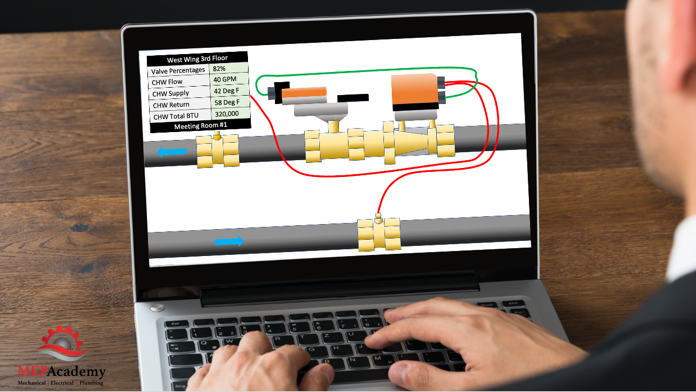
The valve logs the energy consumption for up to 13 months on the valve or for indefinitely when connected to the cloud. The control range signal is set at the default of 2 – 10 VDC.
